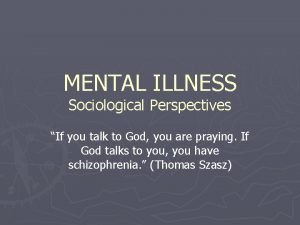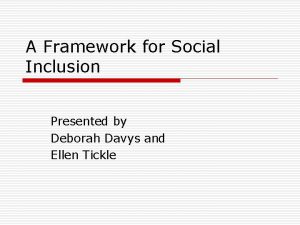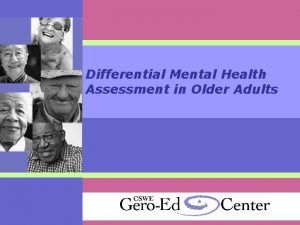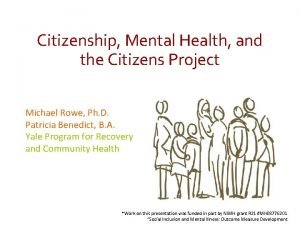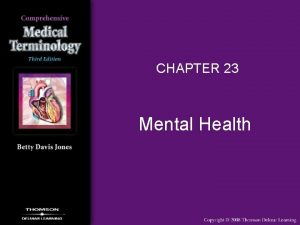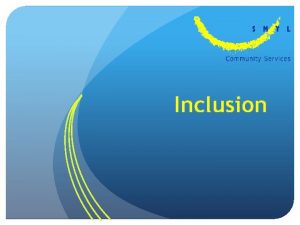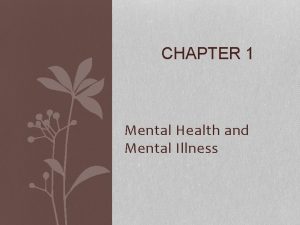Mental Health and Social Inclusion An OT Perspective















- Slides: 15

Mental Health and Social Inclusion: An OT Perspective By Reannen Ryles and Natalie Saunders

What is Occupational Therapy � Enabling satisfying and meaningful lives through occupations. � Occupation: the engagement or participation in recognizable everyday life endeavour. � Physical illness, injury or disability, mental illness and the process of aging can all impact on participation in everyday activities.

Occupational Therapy Continued � Assessment: ◦ ◦ ◦ Physical Cognitive Sensory Psychosocial Environments Motivation � Intervention ◦ ◦ Building skills and capacity Education Assistive equipment Modifying the environment

OT Perspective: P-E-O Model PERSON OCCUPATIONAL PERFORMANCE: the “doing of occupation” (Meriano & Latella, 2004) Values & beliefs Identity Roles & routines Skills & strengths Physical, cognitive & psychosocial status OCCUPATION ENVIRONMENT Self-care Productivity Leisure Rest/Sleep Physical Social Cultural Legislative Institutional

OT’s Role in a Community Mental Health Team � Assertiveness � Cognition � Independent living � Vocational interests and pursuits � Self-awareness � Interpersonal and social skills � Stress management � Activities of daily living � Role development � Self-sufficiency and interdependency � Wellness.

Similarities between OT & Graceville frameworks � Holistic � Person-centred - self identified goals - individual is expert in own life � Focus on strengths, not limitations � Focus on clients interests � Encouragement of independence – ‘tool box’

OT-specific Approach � Top-down approach to recovery � Occupation as means and goal of intervention Occupation Activity Task Performance Components

Barriers to Social Inclusion in the Community � Internal ◦ ◦ ◦ ◦ Motivation Patience Enthusiasm Anxiety Fear Self-control Perceived stigma Pain/ physical health/ vision ◦ Personality � External ◦ Access & Transport ◦ Finance ◦ Stigma ◦ Limited job vacancies ◦ Visitor policies ◦ Social/ family support ◦ Weather

Enablers of Social Inclusion � Internal o Insight o Motivation o Good self-esteem o Positive selfidentity o Impulse control o Spirituality o Coping skills � External o o o Access & transport Location of Graceville Public Trust Service cars Graceville support staff Graceville residents

Case Study: K. H. PERSON • Low motivation • Low self-control • Enjoys the transaction of $ • Fear & Anxiety • Diabetes OCCUPATION ENVIRONMENT • Op-shopping • Collecting • Looking after pets • Watching TV • Grocery shopping • Visiting mum • Location of G/V central • Restricted to Nambour • Graceville support • Limited family support • Stigma • Public Trust • Meals on Wheels

Approaches to Intervention: Remediation vs. Compensation � Remediation: ‘the act of treating a “condition” and allowing an individual to regain lost skills and function’ � Compensation: ‘provides opportunity for independent performance through adapting the task or introducing tools/equipment to the client’

O. T. Perspective: Recommendations for Social Inclusion � Education - Remediation & compensatory approaches - Mental health info night at church - Coping mechanisms

OT Perspective: Recommendations for Social Inclusion � Utilizing service cars to initially engage client in occupation where appropriate - Compensatory approach - Highlights use of OT top-down approach � Grading demands of activity - Remediation approach � Weekly planner - Compensatory approach

O. T. Perspective: Recommendations for future research � Motivational assessments � Motivation interventions and strategies � Reducing community stigma - advocating

References Atchison, B. , & Dirette, D. (2007). Conditions in Occupational Therapy: Effect on occupational performance. Ed 3 rd, Philadelphia. Lippincott Williams & Wilkins American Occupational Therapy Association. Retrieved from: http: // www. aota. org/Consumers/consumers/ Mental. Health/Community/35166. aspx Christiansen, C. H. , & Townsend, E. A. (2004). Introduction to occupation: The art and science of living. (2 nd ed. ). Upper Saddle River, New Jersey: Pearson. Duncan, A. (2006). Model of Human Occupation; Frames of Reference. In Foundations for practice in occupational therapy (4 th ed. ). (pp. 68 -105, 191 -26). Churchill, Livingstone: Elsevier. Meriano, C. , & Latella, D. (2008). Occupational therapy interventions: Function and occupations. Thorofare, NJ: SLACK Incorporated
 Chapter 20 mental health and mental illness
Chapter 20 mental health and mental illness Sociological perspective on mental health
Sociological perspective on mental health Mental health coping skills jeopardy
Mental health coping skills jeopardy Health and social care component 3
Health and social care component 3 Gmef meaning
Gmef meaning Vale digital
Vale digital Social inclusion framework
Social inclusion framework Two point perspective box
Two point perspective box Silo perspective vs business process perspective
Silo perspective vs business process perspective Social thinking social influence social relations
Social thinking social influence social relations Social thinking social influence social relations
Social thinking social influence social relations Chapter 3 achieving mental and emotional health answer key
Chapter 3 achieving mental and emotional health answer key Mental health and older adults
Mental health and older adults Lemhwa report to congress
Lemhwa report to congress Mental health and older adults
Mental health and older adults Mental health and citizenship
Mental health and citizenship

